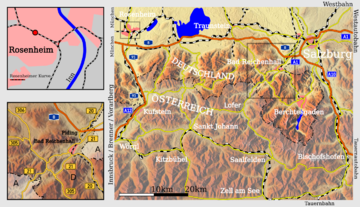- Deutsches Eck (transport link)
-
The Deutsches Eck ("German Corner") is the name given to the shortest and most convenient road and railway link between the Austrian metropolitan region of Salzburg and the Tyrolean Unterland with the state capital Innsbruck.
Due to the irregular course of the border and the mountainous landscape, the main transport routes to the western Austrian states of Tyrol and Vorarlberg cross through the territory of the German federal state of Bavaria. While an alternative, albeit longer, all-Austrian Salzburg-Tyrol Railway exists, there is no continuous intra-Austrian motorway route between the states of Salzburg and Tyrol.
Contents
Großes Deutsches Eck
A larger railway and autobahn (motorway) link runs from Salzburg westwards along the northern rim of the Chiemgau Alps to the Bavarian town of Rosenheim, then turns south through the Inn valley to reach the Tyrolean border at Kufstein.
 Train destination sign of the ÖBB Transalpin EuroCity (1958-2010) from Wien Westbahnhof to Basel SBB
Train destination sign of the ÖBB Transalpin EuroCity (1958-2010) from Wien Westbahnhof to Basel SBB
Since the conclusion of an 1851 treaty between the Austrian Empire and the Kingdom of Bavaria[1], so-called "corridor-trains" of the Austrian Railways (ÖBB) use the Munich–Salzburg and Rosenheim–Kufstein railway lines maintained by the German Deutsche Bahn company against payment of a regular fee. At the Rosenheim rail junction a direct connection (the Rosenheimer Kurve) was erected in 1982 to allow express trains pass quickly without a stop at Rosenheim station.
The parallel German Bundesautobahn 8 links the Austrian West Autobahn at Salzburg with the Inntal three-way interchange near Rosenheim, from where the southern Bundesautobahn 93 leads to the border crossing at Kufstein and the Tyrolean Inn Valley Autobahn. The road connection to Tyrol on Austrian highways via Bischofshofen and Zell am See or Saalfelden is considerably longer.
Kleines Deutsches Eck
A smaller highway connections leads from the southewestern Salzburg outskirts at Wals-Siezenheim across the border on the German Bundesstraße No. 21 along the Saalach river via Bad Reichenhall to Unken and Lofer in the Austrian Pinzgau region. As in Austria, studded winter tires are admitted (while prohibited in the rest of Germany) to spare drivers a tire change.
Since Austria joined the Schengen Area in 1997, all border controls have been abolished, allowing travelers to move freely between both states.
References
- ^ Text of the treaty on alex.onb.ac.at (German)
External links
Categories:- Road transport in Germany
- Rail transport in Austria
Wikimedia Foundation. 2010.

